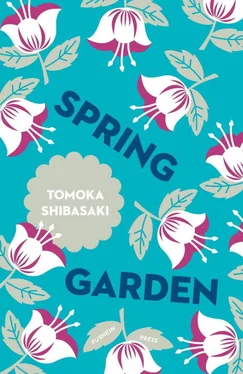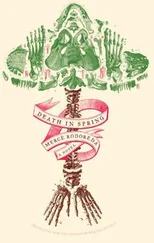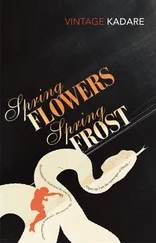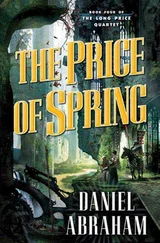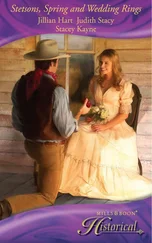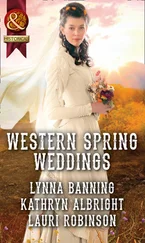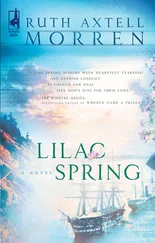Tomoka Shibasaki - Spring Garden
Здесь есть возможность читать онлайн «Tomoka Shibasaki - Spring Garden» весь текст электронной книги совершенно бесплатно (целиком полную версию без сокращений). В некоторых случаях можно слушать аудио, скачать через торрент в формате fb2 и присутствует краткое содержание. Город: London, Год выпуска: 2017, ISBN: 2017, Издательство: Pushkin Press, Жанр: Современная проза, на английском языке. Описание произведения, (предисловие) а так же отзывы посетителей доступны на портале библиотеки ЛибКат.
- Название:Spring Garden
- Автор:
- Издательство:Pushkin Press
- Жанр:
- Год:2017
- Город:London
- ISBN:978-1-78227-273-1
- Рейтинг книги:4 / 5. Голосов: 1
-
Избранное:Добавить в избранное
- Отзывы:
-
Ваша оценка:
- 80
- 1
- 2
- 3
- 4
- 5
Spring Garden: краткое содержание, описание и аннотация
Предлагаем к чтению аннотацию, описание, краткое содержание или предисловие (зависит от того, что написал сам автор книги «Spring Garden»). Если вы не нашли необходимую информацию о книге — напишите в комментариях, мы постараемся отыскать её.
Spring Garden — читать онлайн бесплатно полную книгу (весь текст) целиком
Ниже представлен текст книги, разбитый по страницам. Система сохранения места последней прочитанной страницы, позволяет с удобством читать онлайн бесплатно книгу «Spring Garden», без необходимости каждый раз заново искать на чём Вы остановились. Поставьте закладку, и сможете в любой момент перейти на страницу, на которой закончили чтение.
Интервал:
Закладка:
That landlord’s house was gone now, destroyed in a fire. It happened after Nishi had moved out, and fortunately, there had been no casualties. The house had looked a lot like Mrs Saeki’s, next to View Palace Saeki III. That fact made Nishi suspect that her selection of her current flat wasn’t a complete coincidence.
Spring Garden , which could not now be found in bookshops anywhere, was supposedly a collaboration between Taro Gyushima and Kaiko Umamura, but there was no indication which photos had been taken by whom. The book was the only photo collection that either of them had made. Two years after its publication, the couple divorced. Taro Gyushima became an artist and moved to Berlin. Very occasionally, his name would appear in flyers or announcements for art-related events in Japan, even now. And Kaiko Umamura gave up her acting career. She had never been a major actress to begin with—number three even within her small company, plus the occasional bit-part in films—so it was little wonder that she had disappeared without trace.
In one photo, where sunlight from the window reached a good distance onto the tatami, Kaiko Umamura was right in the middle of it, doing a handstand. Even without a wall for support, her legs were entirely straight, her toes pointed. She must have been an exceptionally sporty type. One of Nishi’s university friends who went to a lot of theatre had told her Umamura often did backwards somersaults in the swordfights of the plays she performed in.
One photo showed a birdcage hanging in the sunroom. Sunlight was coming from behind it, and that part of the photo looked to be deliberately out of focus, so it was hard to know what was in the cage, but it looked like some kind of parrot or parakeet. Who had taken the bird after the divorce? Nishi wondered to herself, and then concluded that it must have been Kaiko. It must have been Kaiko who named it as well. She’d read an article online about how Winston Churchill’s parrot was still alive, so it was highly possible that the bird was still living with Kaiko somewhere now.
When Nishi first moved into her current flat in February, the trees in Mrs Saeki’s garden had been mostly bare, but there were still a lot of birds that came flying through the cold air to perch on them. The electronic dictionary Nishi owned included an Illustrated Guide to Birds among its additional features, and she used the photos and recordings of the bird calls to identify the birds that appeared in the garden: brown-eared bulbuls, Oriental turtle doves, sparrows, tits, azure-winged magpies, and so on. The brown-eared bulbul was described in the Illustrated Guide as having a ‘loud and nagging’ call. She looked it up in a guidebook to wild birds, and learnt that it only existed in Japan and nearby countries, meaning that in the rest of the world it was thought of as a pretty rare species.
Nishi often went out on the balcony of the Dragon Flat with her ring-bound sketchbook to draw the plants that appeared in Mrs Saeki’s garden as the seasons changed, or the cats that went walking along the top of the concrete wall, or the roofs and windows of the houses, and even sometimes the passing butterflies.
Nishi worked as an illustrator and a comic-strip artist. After graduating from university, she was employed by a company that did contract work for an advertising agency. While working there, she had begun to take on illustration jobs on the side, and had quit her job five years ago when a manga series she’d written was given a weekly slot in a magazine. Now, her main jobs were making comic strips out of readers’ stories submitted to a job-seeking portal and a cooking magazine site, and individual commissions for magazines and adverts. On her homepage, she occasionally posted short comic strips based on Chinese legends or idioms that came from particular historical events.
In March, she had met with an editor who had suggested collecting these pieces together and publishing them as a book. At that time, the editor had mentioned in passing a proposal he’d made for a book of photos, rejected on the grounds that books of photos didn’t sell these days, which had prompted Nishi to raise the topic of Spring Garden. But the editor in question, still in his mid-twenties, had heard neither of the book itself nor of Taro Gyushima or Kaiko Umamura, and hadn’t seemed particularly interested. A few days later, though, when stuck for conversation with his boss, the editor had suddenly remembered that her previous job had been something to do with theatre and the arts, and he had asked on a whim if she had heard of Taro Gyushima or Kaiko Umamura. As it happened, his boss had interviewed Kaiko Umamura several times while working for an events magazine. She reminisced to the editor about how she had gone to an after-party for a show, and how, following that, Kaiko Umamura had given her a collection of annotated illustrations that she’d produced after her divorce. The editor, getting excited and declaring this an amazing example of synchronicity, told his boss about how Nishi was a huge fan of Kaiko Umamura’s. The boss thought he was using the word ‘synchronicity’ wrong, but nevertheless, heartened by the fact that this subordinate of hers she found difficult to relate to was listening to her with apparent interest for once, hunted down the collection
of illustrations and brought it in. A few days later, it was delivered to Nishi in a padded envelope.
Made of A4-sized paper folded in half and stapled together, the pamphlet Nishi received was less like a book of illustrations, and more like a handmade zine. It had eighteen pages, colour-photocopied rather than printed. Tiny illustrations in colour pencil, about the size of postage stamps, were scattered randomly across the pages. There was the stained-glass window with the red dragonflies, a wicker chair, the sunroom, various bits of tableware. It seemed like the illustrations were all either parts of the sky-blue house or objects she’d used in there. They were really no more than doodles, but assured doodles nonetheless, that captured the shape of what they were depicting very well. Short writings snaked their way between them.
Wooden houses sure let the cold in! Brrr!
Found a caterpillar on the porch. I really hate insects.
Why does it have to be dragonflies? Insects are gross…
Been studying the strips of fabric round the edge of the tatami mats. The patterns are different on the ground floor and first floors. Something about staring at those nothingy patterns makes me remember being little.
I like this window. The glass is a little bit warped, and it makes it seem like the air outside is warped too. The light bends, changes speed.
I’m soooo sleepy…
Broke a teacup. The thought of sweeping it up and throwing it away made me too sad so I just left it there.
It was mostly jottings, like talking to herself, but through the medium of pen and paper. There was no mention of Taro Gyushima, nor of any of her plays or her friends or anything like that. The booklet was about bits of the house and her thoughts about them.
Nishi was impressed by how good the drawings were. The jottings weren’t fascinating or anything like that, but they seemed exactly like the things that she would have expected the Kaiko Umamura who appeared in that book of photos to say. It came to Nishi that the captions might work perfectly as speech bubbles, so she photocopied the booklet, cut out the lines of text, and tried arranging them on top of the photos.
A few days later Nishi received an email from the same editor, saying that his boss had learnt that Kaiko Umamura was now running a yoga school. He included a link to the yoga school’s website. If it was just a regular yoga school, Nishi thought, then maybe she could go and actually meet Kaiko Umamura in the flesh. With anticipation and a fair amount of apprehension, Nishi clicked on the link to the homepage.
Читать дальшеИнтервал:
Закладка:
Похожие книги на «Spring Garden»
Представляем Вашему вниманию похожие книги на «Spring Garden» списком для выбора. Мы отобрали схожую по названию и смыслу литературу в надежде предоставить читателям больше вариантов отыскать новые, интересные, ещё непрочитанные произведения.
Обсуждение, отзывы о книге «Spring Garden» и просто собственные мнения читателей. Оставьте ваши комментарии, напишите, что Вы думаете о произведении, его смысле или главных героях. Укажите что конкретно понравилось, а что нет, и почему Вы так считаете.
